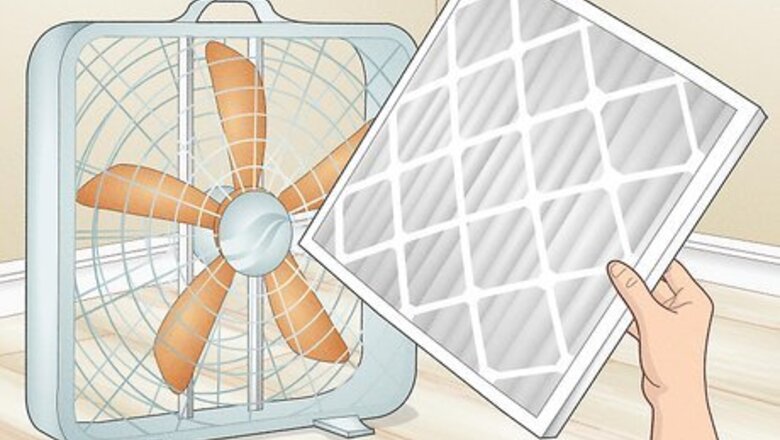
views
Constructing a Simple Box Fan Filter

Purchase a 20 in × 20 in (51 cm × 51 cm) box fan and a MERV 13 filter. You can purchase the filter and fan online or at a building supply store. Any MERV 13 filter will work, although you can upgrade to a HEPA filter if you want the cleanest air possible. If you don’t have a standard box fan, any kind of flat-faced fan should work so long as you can lay a filter over the blades. For the non-box fans, the filter doesn’t need to sit perfectly over the blades. If you have a round table fan or a fan with a rounded cover, remove the face of casing so that you expose the blades. If there is a little peg sticking out of the center, use a handsaw to remove the it and keep the fan flat.
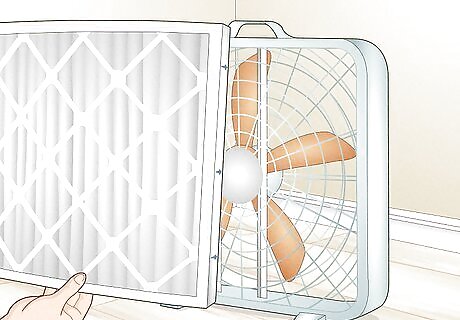
Put the filter behind the fan so that the arrows point towards it. Look for an arrow printed on the filter's frame. Place the filter at the back of the fan so that when you turn the fan on, the filter is on the side that is pulling air into the blades. The arrow on the filter shows you which direction the air is supposed to flow. If the filter is going on the back of the fan, the arrow points to the blades. If you’re using a round or non-standard fan and the filter goes on top of the blades, the arrow should point away from the fan.
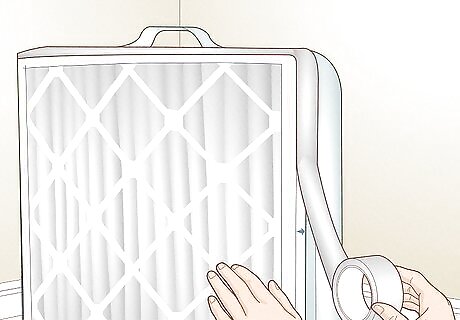
Tape the filter to the fan using duct tape. Use duct tape or another strong adhesive to secure the edge of the air filter to the edge of the fan. Simply lay tape over the filter’s frame and the fan. Repeat this process on each of the 4 sides of the filter to secure it tightly to the fan. If you’re attaching the filter to a round or non-standard fan, you’re going to need to get a little creative with the tape. Use as much duct tape as you need to secure the filter tightly to the frame. Don’t worry if there are any tiny gaps you can’t keep covered—the filter will still work.
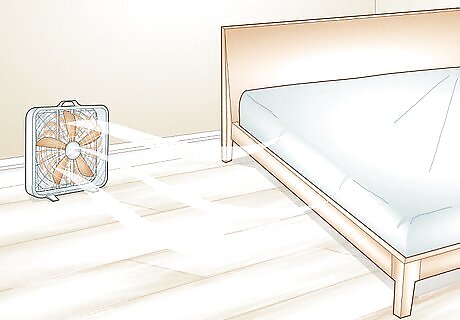
Put the filter in an enclosed room and turn it on. Small fan filters work most efficiently in smaller rooms, such as bedrooms. Plug the fan in and turn it on to begin filtering the air and removing harmful particles. Replace the filter after 90 days or so to ensure that it continues cleaning the air.
Building a Corsi-Rosenthal Box
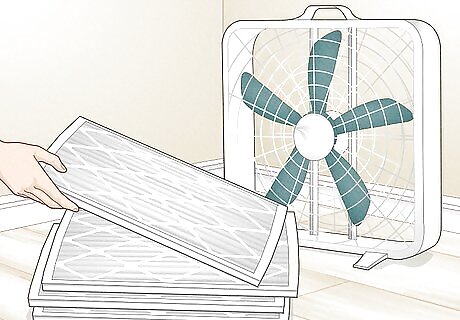
Purchase a 20 by 20 in (51 by 51 cm) box fan and 4 MERV 13 air filters. You can purchase everything you’ll need to create a standalone air purifying box online, or at a building supply store. You’ll need a box fan that measures 20 by 20 inches (51 by 51 cm), which happens to be the standard size for box fans. You’ll also need 4 of those $15-20 MERV 13 air filters that are designed for HVAC units. The Corsi-Rosenthal box was designed during COVID-19 as a cheap way to keep the air clean. The box is named after the two individuals who invented the DIY air purifier. Any kind of air filter will work for this, and MERV 13 filters will really get the job done. HEPA (high efficiency particulate air) filters are as good as it gets, although they do tend to be a little more expensive. HEPA filters have MERV ratings, which refer to the size of the particles the filter can capture. For a Corsi-Rosenthal box, MERV 13 filters are ideal.

Cut out a cardboard sheet that measures 20 by 20 inches (51 by 51 cm). You can use corrugated cardboard or posterboard instead of cardboard if you don’t have any. Lay one of your air filters on top of the cardboard and trace it with pen or pencil. Then, use scissors or a utility knife to cut the cardboard out. This cardboard sheet is going to be the base/floor of the air filter. The air filters are going to be the walls, and the box fan will go on top.
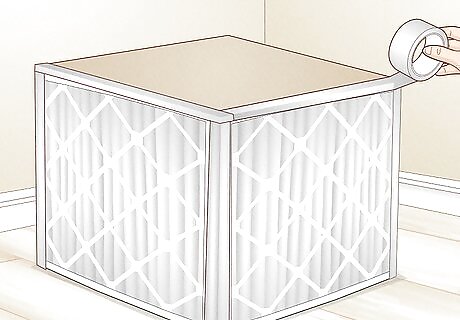
Tape the 4 filters together in a square and add the cardboard sheet. Stand the 4 filters up in a square shape. Check the sides of the filters to see which direction the arrows are pointing and orient each filter so that it points in towards the center of the box. Use duct tape or packing tape to secure the cardboard to the 4 filters in a square. The arrows on the filters indicate which direction the air is supposed to flow. In this case, you want the arrows pointing inward because you want the air to be cleaned as it enters the middle of the box. This way, the fan will blow out the cleaned air.
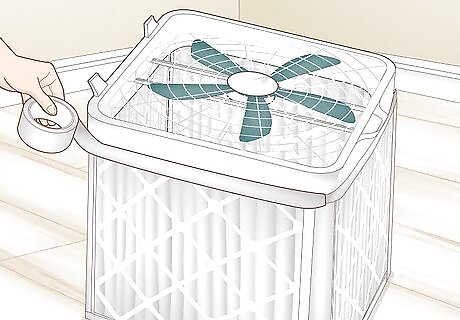
Put the box fan on the open side and tape it. Flip your box over so the cardboard is at the bottom. Lay the box fan over the open side of the cube with the front of the fan pointing away from the cube so that the air would blow up. Use a generous amount of tape to secure the fan to the filters. Ensure that each air gap between the frame of the fan and the filters is covered up. If you aren’t sure which side of the fan to put facing out, plug it in. Whichever side blows the air out is the one you want pointing away from the box.
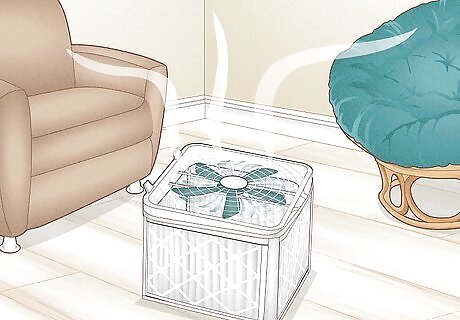
Set the box in a central part of the room with little ventilation. Keep the box fan on top and place the cube on the ground. Plug it in and let the fan do its job. The fan will pull the air into the filters, clean it, and then blow it out. This will remove irritants, allergens, and bacteria from the air so that you can breathe easy and stay healthy. This air purifying unit should last 6 months. After a half year passes, deconstruct the box and rebuild it using new filters. If you’re painting a home or spraying pesticides, bring the box with you whenever you move to a different room to keep your lungs safe.
Creating a Bucket Air Purifier

Get a small table fan, a large bucket, and measure them. The fan must be smaller than the bucket for this to work. Use a 2–5 US gal (7.6–18.9 L) bucket for maximum space and filtration. Measure the diameter of the fan and then subtract about ⁄2 in (1.3 cm) from the final measurement. Subtracting a little length from the diameter ensures the fan won’t fall through the lid when you put it at the top of the bucket.
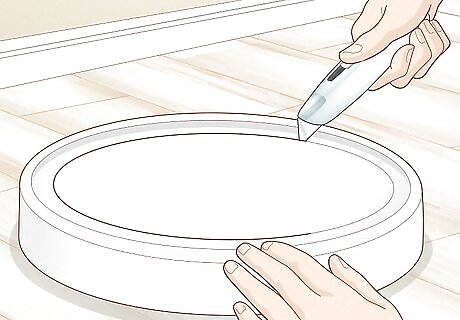
Cut a hole for the fan in the bucket’s lid with a utility knife. Use a marker to outline the fan (minus that ⁄2 in (1.3 cm)) on top of the bucket’s lid. Use a utility knife to carve out the plastic and create the opening for your fan. Work carefully to avoid damaging the outer edges of the lid. Remember to make the hole a little smaller than the diameter of the fan. Center the hole and keep it as even as possible all the way around.
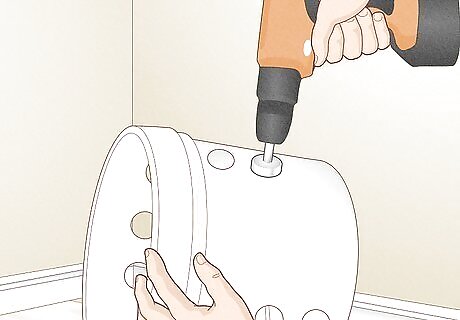
Drill holes around the sides of the bucket to let air into it. Attach a 1 ⁄2 in (3.8 cm)-diameter hole saw to your drill. Drive holes into the bucket in even rows, leaving about 1–2 in (2.5–5.1 cm) of space between each hole. Make as many holes as you can while leaving a consistent amount of space between each hole. Every row on the bucket should have some airflow. Try making some of the holes a different size. Drill 4 columns on opposing sides, then switch to a 2 in (5.1 cm) drill bit. Fill in the remaining space with columns of bigger holes. Consider sanding the holes smooth with 120-grit sandpaper or a rotary tool to improve your filter’s appearance.
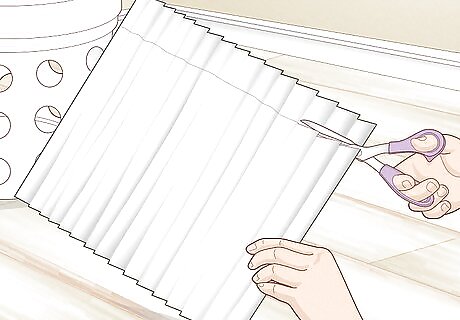
Cut a HEPA filter to match the height and circumference of your bucket. Shop for a HEPA filter, preferably one without a frame. Measure the bucket from the bottom to just above the top hole you drilled in the side of the bucket. Measure the interior circumference of the bucket as well. Then, cut the frame to size with scissors. If your filter has a frame on it, cut around the frame first to remove it. Another option is to install the filter on the side of the bucket by drilling one big hole instead of a bunch of small ones.

Roll the filter up and fit it inside of the bucket. Use the filter as a liner inside the bucket. Push it against the sides of the bucket until it sticks in place, covering the holes completely. The filter should sit in place perfectly, but you can add glue or duct tape to keep it from sliding around.

Cut a notch in the top edge of the bucket for the fan cord. Use a utility knife or another tool, such as wire cutters, to make the notch. Make it about ⁄4 in × ⁄2 in (0.64 cm × 1.27 cm) in size. Test the notch by attempting to slide part of the fan’s electrical cord into it. Make sure the cord stays firmly in the notch, out of the way of the lid.
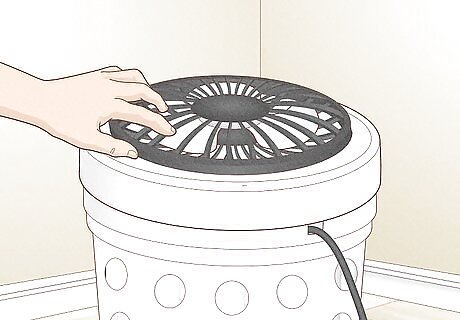
Fit the fan inside the lid and the bucket. Slide the fan through the lid so the fan’s blades face upward. The top half of the fan’s case sits on top of the bucket so the fan blades blow air back into the room. Drop the base of the fan down into the bucket, leaving the cord in the notch you cut. Plug the fan into the nearest wall outlet to begin purifying the air in the room. Change the filter out every 3 months to ensure that the air stays clean.


















Comments
0 comment